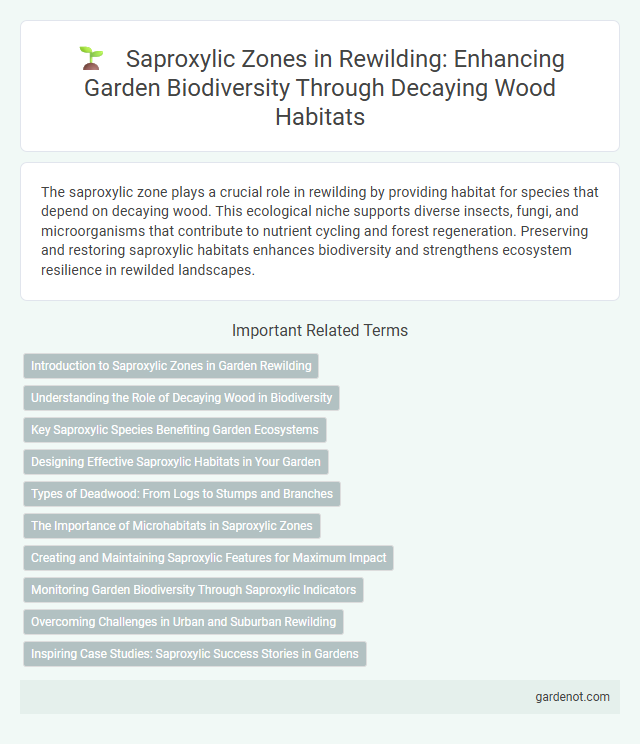The saproxylic zone plays a crucial role in rewilding by providing habitat for species that depend on decaying wood. This ecological niche supports diverse insects, fungi, and microorganisms that contribute to nutrient cycling and forest regeneration. Preserving and restoring saproxylic habitats enhances biodiversity and strengthens ecosystem resilience in rewilded landscapes.
Introduction to Saproxylic Zones in Garden Rewilding
Saproxylic zones in garden rewilding create essential habitats by preserving deadwood and decaying trees, supporting biodiversity through the promotion of fungi, insects, and other decomposers. These zones enhance ecosystem functions such as nutrient cycling and soil health by fostering complex food webs dependent on rotten wood. Incorporating saproxylic zones in rewilded gardens boosts native species conservation and strengthens ecological resilience.
Understanding the Role of Decaying Wood in Biodiversity
Saproxylic zones, characterized by decaying wood, are critical habitats supporting diverse ecosystems that rely on deadwood for survival. These zones promote biodiversity by providing essential resources for fungi, insects, birds, and mammals, contributing to nutrient cycling and forest regeneration. Protecting and restoring saproxylic habitats enhances ecosystem resilience and supports species dependent on the complex structures of woody debris.
Key Saproxylic Species Benefiting Garden Ecosystems
Key saproxylic species such as stag beetles (Lucanus cervus), hoverflies (Syrphidae), and woodlice (Oniscidea) play a crucial role in garden ecosystems by promoting nutrient cycling and enhancing soil health through the decomposition of deadwood. These species support biodiversity by creating microhabitats that foster the growth of fungi and other decomposers essential for ecosystem balance. Protecting saproxylic zones encourages the survival of these species, improving ecological resilience and plant vitality in rewilded gardens.
Designing Effective Saproxylic Habitats in Your Garden
Creating effective saproxylic habitats in your garden involves preserving deadwood and ensuring a variety of wood decay stages to support diverse insect species. Incorporate large logs, standing snags, and decaying tree trunks in shaded, moist areas to optimize conditions for saproxylic beetles, fungi, and other decomposers. Monitoring moisture levels and avoiding chemical treatments enhances habitat quality, promoting biodiversity and contributing to the rewilding process.
Types of Deadwood: From Logs to Stumps and Branches
Saproxylic zones depend on a variety of deadwood types, including fallen logs, standing stumps, and branches, each providing unique habitats for fungi, invertebrates, and birds. Logs retain moisture and offer a stable environment for wood-decay organisms, while stumps serve as critical nesting sites and feeding grounds. Branches, often overlooked, contribute to biodiversity by creating microhabitats for saproxylic beetles and mosses essential for ecosystem rewilding.
The Importance of Microhabitats in Saproxylic Zones
Microhabitats within saproxylic zones host diverse communities of fungi, invertebrates, and microorganisms essential for nutrient cycling and forest ecosystem health. The presence of deadwood, bark cavities, and decaying wood structures creates critical niches that support saproxylic beetles and other wildlife dependent on decomposing organic matter. Protecting these microhabitats enhances biodiversity, promotes natural forest regeneration, and maintains ecological processes key to rewilding efforts.
Creating and Maintaining Saproxylic Features for Maximum Impact
Creating and maintaining saproxylic features such as deadwood piles, standing snags, and hollow trees significantly enhances biodiversity by providing essential habitats for fungi, insects, and cavity-nesting species in rewilding landscapes. Strategic placement and gradual decay processes of these features support nutrient cycling and complex ecological interactions. Regular monitoring and adaptive management ensure the longevity and quality of saproxylic habitats, optimizing their ecological impact within rewilding projects.
Monitoring Garden Biodiversity Through Saproxylic Indicators
Saproxylic zones play a crucial role in monitoring garden biodiversity by serving as indicators of ecosystem health through the presence of decaying wood-dependent species. Tracking saproxylic beetles and fungi provides valuable data on habitat quality and the effectiveness of rewilding practices. These bioindicators help assess biodiversity changes over time, guiding conservation efforts in garden ecosystems.
Overcoming Challenges in Urban and Suburban Rewilding
Saproxylic zones, rich in decaying wood habitats, are critical for biodiversity but face significant challenges in urban and suburban rewilding due to habitat fragmentation and limited deadwood availability. Implementing strategic deadwood management and creating microhabitats can enhance saproxylic species survival and ecosystem resilience. Integrating community awareness programs and ecological corridors facilitates connectivity, promoting the recovery of saproxylic populations within urban landscapes.
Inspiring Case Studies: Saproxylic Success Stories in Gardens
Saproxylic zones, which harbor organisms dependent on decaying wood, have been successfully integrated into garden rewilding projects, fostering biodiversity and ecological resilience. Case studies reveal that the introduction of deadwood piles and veteran trees in urban gardens supports rare beetles, fungi, and saproxylic insects, enhancing local wildlife networks. These inspiring examples demonstrate how small-scale saproxylic habitats contribute significantly to conservation efforts and promote natural regeneration within managed landscapes.
Saproxylic zone Infographic

 gardenot.com
gardenot.com